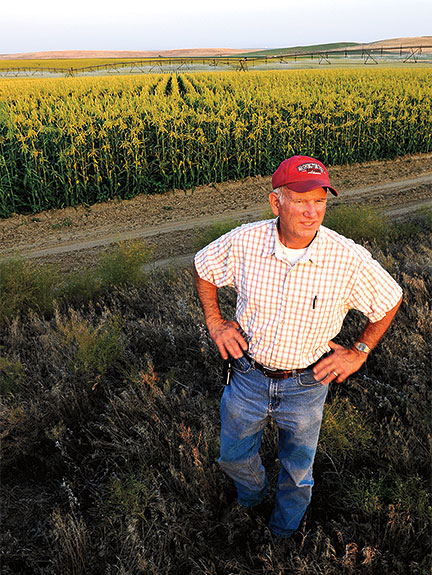Washington corn? Midwesterners may scoff, but right now an abundance of sweet corn from Yakima Valley and around the Columbia Basin is heading to grocery stores, farm stands, and farmers markets from Anacortes to Zillah. It is something of a surprise that our state is also one of the largest sweet corn producers in the country.
The stuff at the farm stands is just a hint of how much of the crop is here. Three states dominate in the production of sweet corn for canning and freezing. The first two are no revelation: Wisconsin and Minnesota. But some years Washington is the source of 850,000 tons of the succulent seed, nearly 200,000 tons more than Wisconsin. And last year, Washington led the nation in sweet corn production.
In Benton and Franklin Counties, “it’s a pretty important rotation crop,” says WSU extension agent Tim Waters. It’s a C4 grass and as a grass it’s pretty good for breaking disease cycles in fields for typical Columbia Basin crops like potatoes, onions, and carrots. The C4 classification refers to the plant’s super-efficient ability to fix carbon in the right conditions: warm weather and plenty of water. Most grasses are C3.
Corn, also known as maize, is a crop native to the Americas. It started as a grass and was likely first cultivated about 8,700 years ago in what is now southwestern Mexico. Only recently have scientists determined that it is descended from teosinte, a grass that heads a skinny “ear” with only about 12 seeds or kernels.
It’s a beautiful example of farmers over centuries selecting for traits like size and yield. Then dramatic change came in the twentieth century when seed companies and university research programs focused on breeding and hybridizing the plant to increase yields, improve disease resistance, and enhance sweetness, among other things. The University of Illinois is credited with the first supersweet varieties.

So why is it here? Irrigation is the key. Corn needs sufficient water during three critical stages: tasselling, silking, and earfill. Without it the ear doesn’t fill out. In the Columbia Basin “when you want the water, you turn it on. When you don’t, you turn it off,” says Guy Madison ’78, who works as a consultant at 100 Circle Farms.
Nowadays growing the crop is a precise science, says Madison. “You’re basically a plant doctor, focusing on the interrelations of the nutrients in the soil and asking questions on a daily basis,” he says. Some of those questions come through soil and tissue samples checking to see if the plant needs more nitrogen, phosphate, or zinc. “We’re asking the plant, ‘How are you feeling? Are you lacking something?’”
One of the beauties of farming corn in the Columbia Basin is that it can be used in double cropping systems, so the farmers can harvest two different crops from the same field in a single year, says Waters. First they plant a pea crop in February and by June are ready to harvest and follow it with corn, which ripens from June to October. Since peas fix nitrogen, and corn requires it, it’s a perfect pairing.
The corn is planted right on the heels of the pea harvest, says Madison. While the combines are rolling through the fields picking up the peas, the planters are sometimes right behind them putting down the corn.
At 100 Circle Farms, Madison grows corn, peas, and other crops in irrigated circles. The corn harvest itself happens quickly, with a team of combines working a field to fit it in the optimal window during which the sweetness, tenderness, and moisture are just right. From there it’s a quick trip (often under an hour) to the processing plant before the rapid change of sugar sweet to starch. “When everyone else goes to bed, they’re running 24/7,” says Madison.
Harvest in the Basin starts in mid-July and runs through October. West of the Cascades, it starts in late August. If you have fresh corn, the best way to prepare it is to “grab it off the stalk and throw it into boiling water,” says Waters. “The longer you wait from picking to eating affects the flavor a bit.”
Besides the big-scale processing farms, there are small farms growing corn around the state. Last spring Ken Christianson ’74 and his son Eric ’12, a graduate student at WSU Mount Vernon, planted two fields of hybrid sweet corn on their small Skagit Valley farm.
A few years ago they bought their neighbor’s place, where sweet corn has been grown and sold locally for over 20 years. “We decided to carry on the tradition,” says Ken Christianson, who owns a tree nursery and before that worked in the vegetable seed business. He loves growing plants from seed.
The father and son put just over an acre of yellow supersweet corn and about a quarter acre of white supersweet. When it’s ready for harvest in late August and early September, they plan to stock their roadside stand with the corn.
“I think the Skagit is a great place for sweet corn roadside production,” says Christianson. The ample water and days in late summer when the temperature is in the mid-80s provide the Christiansons and their neighbors the right conditions for a delicious crop. For timing, they can’t compete with the early cropping possible in Eastern Washington, says Christianson, but “the quality of local-grown is worth the wait.”
